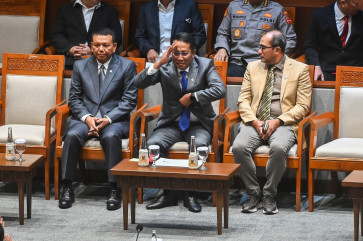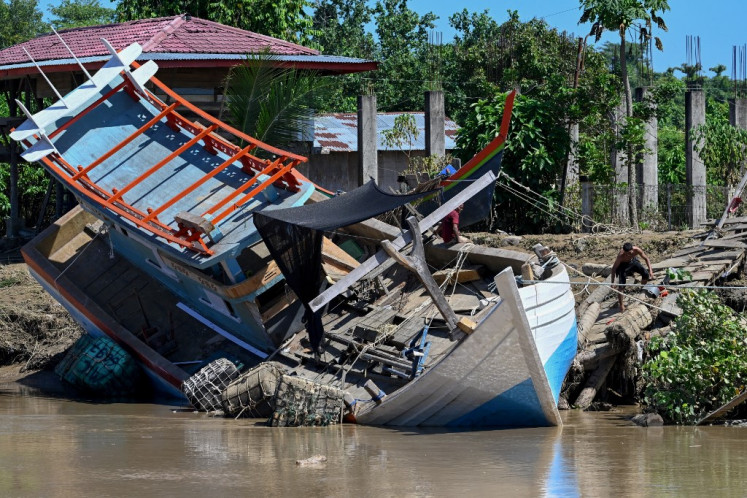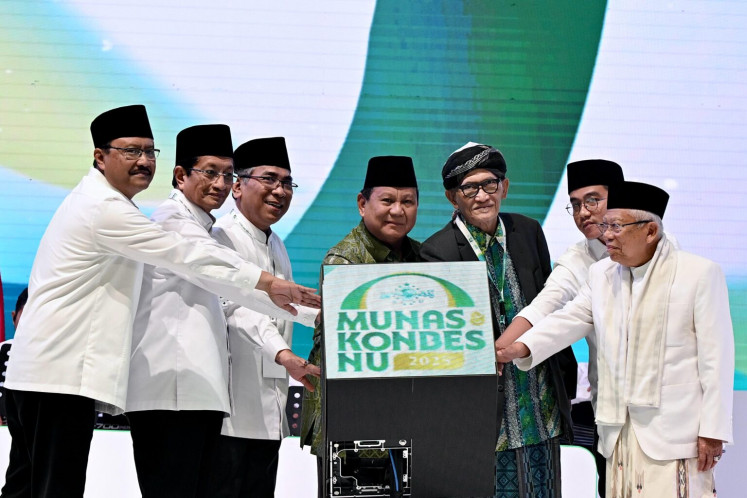Popular Reads
Top Results
Can't find what you're looking for?
View all search resultsPopular Reads
Top Results
Can't find what you're looking for?
View all search resultsPreserving hamlets via art in Sekejolang
A lionâs roar: Children from Sekejolang hamlet, Ciburial village perform the Sisingaan (lion) dance near the Djuanda Forest Park in West Bandung regency, West Java, on Sunday
Change text size
Gift Premium Articles
to Anyone
A
span class="caption">A lion's roar: Children from Sekejolang hamlet, Ciburial village perform the Sisingaan (lion) dance near the Djuanda Forest Park in West Bandung regency, West Java, on Sunday. The performance was part of an effort to intensify opposition to a planned park expansion that would threaten the hamlet. JP/Arya Dipa
Around 100 residents, including children, danced and sang in a performance in Sekejolang hamlet, Ciburial village, West Bandung regency, West Java on Sunday.
They livened up an event called 'Arts Performances for the Forest' on an open-air stage in nearby Djuanda Forest Park, which aimed to preserve their hamlet.
Prior to the event, a village elder burned coconut husk on an earthenware plate. The coconut husk was used to burn incense as a symbol to begin prayers before the start of the event.
Offerings, in the form of red and white rice porridge, coffee, coconut, palm sugar, eggs, cigars, salt and a variety of fruit were placed on a tray. They symbolized the diversity in the world, while the egg represented life.
After reciting prayers in Sundanese, a number of teenagers played the calung percussion instrument and sang to entertain residents attending the event.
At a glimpse, the Sundanese songs seemed common enough, but the lyrics spoke of the village and told stories of water that flowed, birds that chirped, the pristine forest and prosperity.
After that, it was the children's turn to perform the sisingaan (lion) performance.
Four children carried a lion-shaped effigy.
Hamlet leader Aep Sutarya, 49, said the activity was intentionally held to teach the younger generation about their cultural heritage.
'They should not be ignorant of the cultural heritage of their ancestors,' said Aep.
Furthermore, added Aep, the government planned to expand Djuanda Forest Park, which was inaugurated by former president Soeharto in 1985.
The government intends to extend the area that spans 529 hectares (ha) to 2,750 ha, most of which are under the management of the Perhutani state forestry firm, including a 7-hectare enclave inhabited by around 400 people in Sekejolang.
Djuanda Forest Park consists of 26 ha, with Sekejolang hamlet being the only inhabited area.
A large section of the area is farmland. The planned expansion of the area is stated in bylaw No. 25/2008 on Djuanda Forest Park management.
The government is required to free up the area around Djuanda Forest Park, which is not a conservation area.
Aep said residents were steadfast about remaining in the area that they had inhabited a while back.
He said the government and the forest park's management should be aware of the cultural wealth within the hamlet.
'To us, the land is everything. Our ancestors were here before the forest park area was determined,' said Aep.
The planned development of Djuanda Forest Park has also drawn the attention of Social Welfare Institute post-graduate student Untung Aji Pramono.
According to Untung, the Sekejolang community does not regard the land as only serving an economic function.
For them, the land also connects one generation to the next.
'The moment they are separated from the land, they will face difficulties. The concern could have been overcome had the government and legislature shown the will to amend the current bylaw,' said Untung.
Meanwhile, Djuanda Forest Park management center head Imam Santoso said his center was able to acquire 3.3 ha of land valued at Rp 4 billion (US$343,864) in 2013.
The funds were derived from the West Java provincial budget.
'However, for this year, we will not acquire. Last year we also failed to buy land from six residents as the price was just not feasible,' said Imam.










